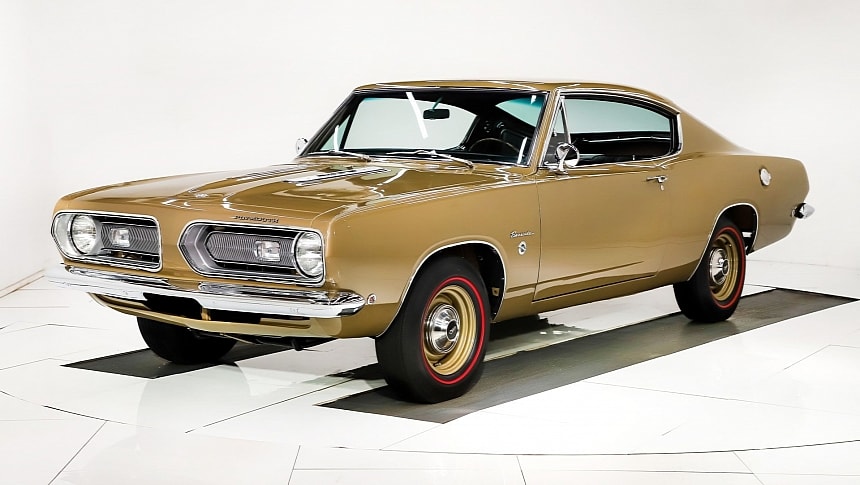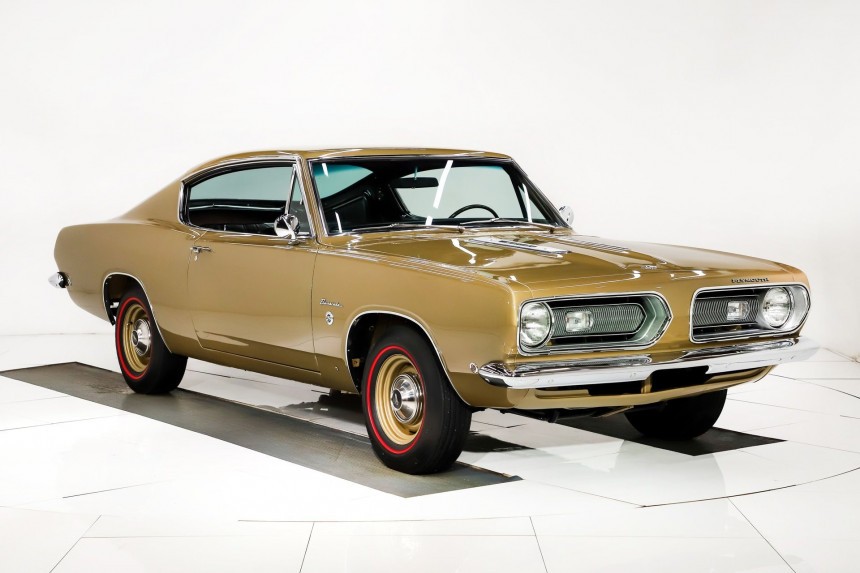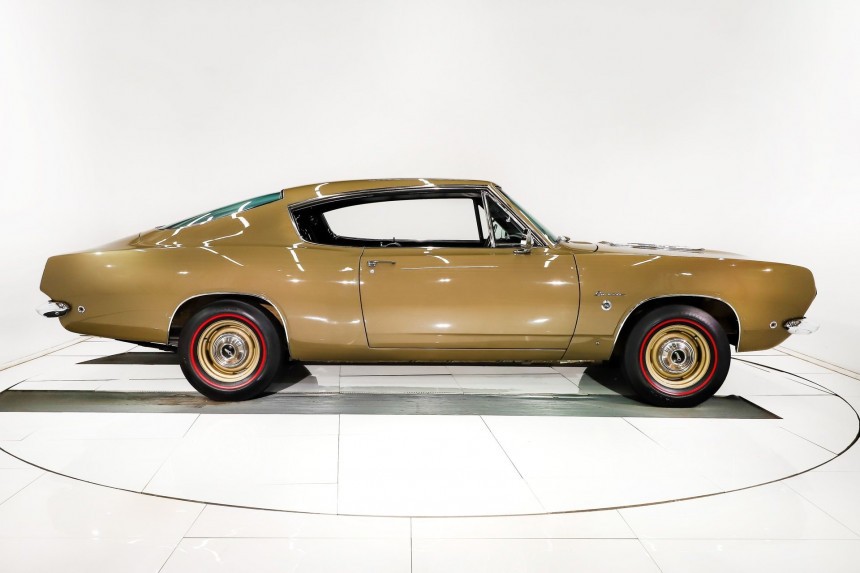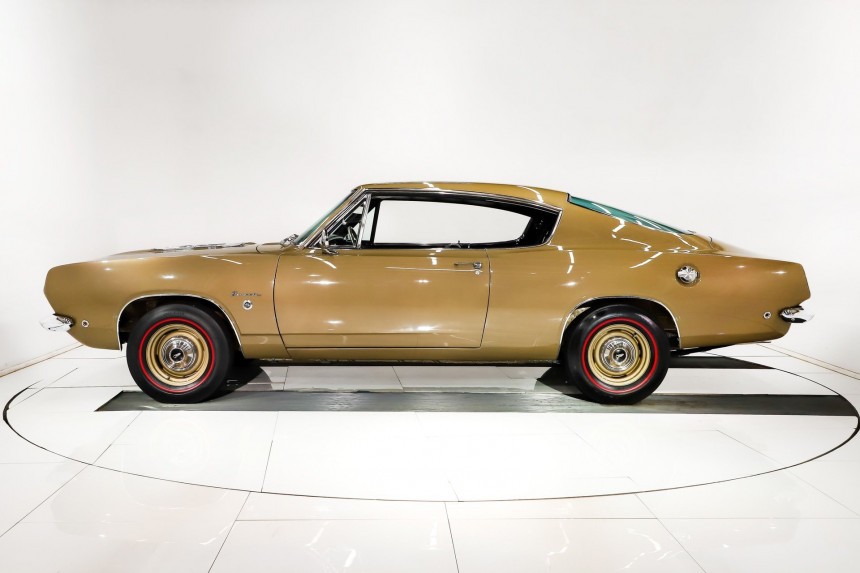The second generation of the Plymouth Barracuda ‘pony’ car hit the market in 1966 as a 1967 model and went into retirement at the end of the 1969 production year. Three short years, overlapping precisely with the era’s second-place sensation, the Chevrolet Camaro, and its corporate cousin, the Pontiac Firebird. However, unlike the almighty Mustang and the General Motors newcomers, the Barracuda trailed at the bottom section of customer preference charts.
Tired of being the laugh of the money-making party, Plymouth threw in the ace in the sleeve, the go-fast options for the already high-performance variant, the Formula S. The package debuted in 1965. Still, it convinced few customers that extra horsepower would be worth the costs. The Plymouth Barracuda Formula S was never a hot cake on the Mopar menu, despite Chrysler’s repeated attempts to make it spicier every year.
In ’65, there was the 273 cubic-inch Commando V8 (4.5-liter) with its 235 hp—and it was carried over to 1966. With 10.5:1 compression and a single four-throat carburetor, the motor was the best a Barracuda could hope for in its first generation. Things changed for the better with the arrival of the second generation, when the 273 was phased out in favor of a triplet of V8, two of which powered the Formula S models.
In 1967, the 273 V8 made its final appearance, but it played second fiddle in the performance act, only accompanying the virtuoso 383 V8. The 6.3-liter Chrysler big-block was the top dog for the Formula S Package. That year marked the high water mark for the Formula S Barracudas. At the end of the production year, the 273 was scrapped, leaving the small-block V8 duties to a pair of newcomers.
The 318 LA V8 had replaced the hunky 318 Poly at the end of 1966, but the Barracuda had to wait for another season to get it, and the 340 small-block (5.6-liter) joined the show in 1968. Formula S cars benefitted from the 340 and 383 plants for their final two years on the market. The nameplate's third generation introduced a completely new Barracuda, the E-body that brought along all Chrysler engines, bar none.
That was, in fact, one major complaint against the otherwise sexy-looking pony Mopar of the 1964-1969 generations: the absence of the fabled heavy-punching big-blocks, the 440 and the 426 Hemi. Granted, the 440 V8 managed to somehow squeeze all of its 7.2 liters between the shock towers of the ‘Cuda in 1969, but it still wasn’t enough.
Following a peak production of over 7,000 examples in 1967, the Formula S package rapidly descended in its last two seasons. In 1968, some 5,000 Plymouth Barracuda automobiles were ordered with the fun package, and in 1969, the volume shrunk to some 2,500 units. The 383-powered Formula S ‘Cudas were a minority in all three years, leaping downward each season.
From the peak of 1,784 cars built for the 1967 model year, the drop of 664 orders was a catastrophe, and 1969 hit rock bottom with 718 Formula S cars. The nosedive accurately followed the models’ overall sales, which plunged from 62,534 in ’67 to 31,987 in ’69. Surprisingly, for a relatively rare variant of an iconic nameplate, the Formula S is not particularly cherished by collectors nowadays.
Over the last five years, Formula S units have changed hands for what a rust-bucket carcass of a second-gen Dodge Charger would start at (around $30,000). The notable exceptions would be the convertible Barracudas, but even those float in the $100k range (usually under that threshold). So then, what is the matter with this particular car that’s asking $87,000 from a new buyer?
It’s a restored example (rotisserie-turned) with a 383 and an automatic. It’s also from 1968 and a fastback, making it one of the 1,120 examples fitted with the big-block and wearing the Formula S package. Being a Torqueflite three-speed self-shifting transmission makes this particular car just one of the 516 high-performance Barracudas from that year.
The icing on the cake is that just two years ago, this very car was bought for $47,300, almost four grand under the current asking price. Between November 2022 and June 2024, the old Mopar garnered just under 1,000 miles (5,578 / 8,977 km then versus 6,565 / 10,565 km today). It has a 3.23 Sure Grip rear axle, an indiscriminate number of non-original parts, and insufficient history to explain the high price.
We don’t know if the mileage is original, but chances are very strong on the disappointing news about that aspect. The selling dealer claims the Super Commando 383/300-hp motor is the numbers matching block and that it was rebuilt and upgraded at some unspecified point in the past. It now rocks a hotter cam, an aluminum intake with a 750 Holley carb, electronic ignition, and Jet Hot coated headers for the stainless dual-exhaust X-pipes.
The gearbox, driveshaft, and suspensions were also rebuilt (upgraded with Koni dampers on all four corners). Rebuilt steering and braking systems keep this rare Barracuda safely on track (four-piston disc brakes upfront). The fuel system, tank, and lines are completely new.
In its defense, the car is gorgeous inside and out and runs and drives great (play the video at 10:20 to hear the 300-hp, 400-lb-ft / 305 PS, 542 Nm burble and lay some rubber on the driveway). Since this particular 1968 Formula S is a fastback, the powertrain-body configuration makes it one of the 395 Barracudas in this setup. Rare, I agree, but is it 87,000 dollars’ worth of rare?
In ’65, there was the 273 cubic-inch Commando V8 (4.5-liter) with its 235 hp—and it was carried over to 1966. With 10.5:1 compression and a single four-throat carburetor, the motor was the best a Barracuda could hope for in its first generation. Things changed for the better with the arrival of the second generation, when the 273 was phased out in favor of a triplet of V8, two of which powered the Formula S models.
In 1967, the 273 V8 made its final appearance, but it played second fiddle in the performance act, only accompanying the virtuoso 383 V8. The 6.3-liter Chrysler big-block was the top dog for the Formula S Package. That year marked the high water mark for the Formula S Barracudas. At the end of the production year, the 273 was scrapped, leaving the small-block V8 duties to a pair of newcomers.
That was, in fact, one major complaint against the otherwise sexy-looking pony Mopar of the 1964-1969 generations: the absence of the fabled heavy-punching big-blocks, the 440 and the 426 Hemi. Granted, the 440 V8 managed to somehow squeeze all of its 7.2 liters between the shock towers of the ‘Cuda in 1969, but it still wasn’t enough.
Following a peak production of over 7,000 examples in 1967, the Formula S package rapidly descended in its last two seasons. In 1968, some 5,000 Plymouth Barracuda automobiles were ordered with the fun package, and in 1969, the volume shrunk to some 2,500 units. The 383-powered Formula S ‘Cudas were a minority in all three years, leaping downward each season.
Over the last five years, Formula S units have changed hands for what a rust-bucket carcass of a second-gen Dodge Charger would start at (around $30,000). The notable exceptions would be the convertible Barracudas, but even those float in the $100k range (usually under that threshold). So then, what is the matter with this particular car that’s asking $87,000 from a new buyer?
It’s a restored example (rotisserie-turned) with a 383 and an automatic. It’s also from 1968 and a fastback, making it one of the 1,120 examples fitted with the big-block and wearing the Formula S package. Being a Torqueflite three-speed self-shifting transmission makes this particular car just one of the 516 high-performance Barracudas from that year.
We don’t know if the mileage is original, but chances are very strong on the disappointing news about that aspect. The selling dealer claims the Super Commando 383/300-hp motor is the numbers matching block and that it was rebuilt and upgraded at some unspecified point in the past. It now rocks a hotter cam, an aluminum intake with a 750 Holley carb, electronic ignition, and Jet Hot coated headers for the stainless dual-exhaust X-pipes.
The gearbox, driveshaft, and suspensions were also rebuilt (upgraded with Koni dampers on all four corners). Rebuilt steering and braking systems keep this rare Barracuda safely on track (four-piston disc brakes upfront). The fuel system, tank, and lines are completely new.
In its defense, the car is gorgeous inside and out and runs and drives great (play the video at 10:20 to hear the 300-hp, 400-lb-ft / 305 PS, 542 Nm burble and lay some rubber on the driveway). Since this particular 1968 Formula S is a fastback, the powertrain-body configuration makes it one of the 395 Barracudas in this setup. Rare, I agree, but is it 87,000 dollars’ worth of rare?


































